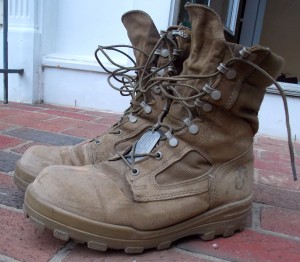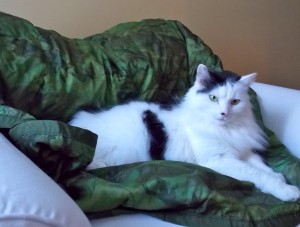Just to clarify (again), being in the military is NOT synonymous with being a prepper. But, it does give you an edge on preparedness. So, I thought I would highlight some of our family’s favorite military items that we use and have in our GOOD (Get Out of Dodge*) bags and/or car kits.
 Military boots have come a LONG way since Vietnam and even Desert Storm. There are a number of “military-approved manufacturers” these days and the boots come in a variety of styles to fit the working conditions. Gone are the days of just “steel toe” or “no steel toe”. There are quality boots for hot weather, cold weather, ultra lightweight, steel toe, and everything in between. The least expensive cost about $100. My husband’s favorites (and mind you, shoes/boots are a very personal choice) are the Bates Durashocks Hot Weather boot, which run about $140. These are a medium weight, suede boot in a natural leather color. He wears these even in cold weather because he says the cold weather boots make your feet sweat unless temperatures constantly stay below 35 degrees. Around military bases there are still shoe repair places (cobblers), so it is common to have your favorite boots resoled and repaired rather than buying new ones.
Military boots have come a LONG way since Vietnam and even Desert Storm. There are a number of “military-approved manufacturers” these days and the boots come in a variety of styles to fit the working conditions. Gone are the days of just “steel toe” or “no steel toe”. There are quality boots for hot weather, cold weather, ultra lightweight, steel toe, and everything in between. The least expensive cost about $100. My husband’s favorites (and mind you, shoes/boots are a very personal choice) are the Bates Durashocks Hot Weather boot, which run about $140. These are a medium weight, suede boot in a natural leather color. He wears these even in cold weather because he says the cold weather boots make your feet sweat unless temperatures constantly stay below 35 degrees. Around military bases there are still shoe repair places (cobblers), so it is common to have your favorite boots resoled and repaired rather than buying new ones.
 When it comes to staying warm and dry, layering is the best method. Two invaluable items, in the military, for this are: Gore-Tex and liners. Gore-Tex is a high-end trademarked fabric used for making outer apparel water-proof and breathable. Most commonly you will see these as big, hooded camo jackets with matching pants. These can be expensive when purchased for personal use, but can be found used and are truly worth their weight in gold. The second component, which you can also find used–and these are inexpensive–are the jacket and pants liners. These are made of a ‘poofy’, olive drab, quilted fabric very similar to a parachute. They are very light weight, easy to compress, and excellent for layering under coats. We purchased a 10-pack of used jacket liners for about $35, including shipping, from eBay. I personally am terrible about NOT wearing coats, even in the winter, so I keep a couple of these stashed in my kit in the trunk of my car.
When it comes to staying warm and dry, layering is the best method. Two invaluable items, in the military, for this are: Gore-Tex and liners. Gore-Tex is a high-end trademarked fabric used for making outer apparel water-proof and breathable. Most commonly you will see these as big, hooded camo jackets with matching pants. These can be expensive when purchased for personal use, but can be found used and are truly worth their weight in gold. The second component, which you can also find used–and these are inexpensive–are the jacket and pants liners. These are made of a ‘poofy’, olive drab, quilted fabric very similar to a parachute. They are very light weight, easy to compress, and excellent for layering under coats. We purchased a 10-pack of used jacket liners for about $35, including shipping, from eBay. I personally am terrible about NOT wearing coats, even in the winter, so I keep a couple of these stashed in my kit in the trunk of my car.
 The last thing I will mention is the military poncho liner, affectionately known in the military as a “wooby”. It is made from the same parachute type quilted fabric as the jacket/pants liners. It is also easy to compress and pack along. BUT, in my opinion, it’s greatest strength is that things don’t stick to it. That means I can use it in sand or dirt, then just pick it up and shake it off. Even pet fur tends to just slide right off. Also it will not only keep you warm, but when used in a warm climate it feels cool against your skin (you won’t sweat up against it). Since the military changed to a digital camo pattern, there are plenty of these for sale in the outdated “woodland” camo pattern. They can be found online from about $10-30. Our family owns several, keeps them in our GOOD Bags, and also packs them along whenever we travel.
The last thing I will mention is the military poncho liner, affectionately known in the military as a “wooby”. It is made from the same parachute type quilted fabric as the jacket/pants liners. It is also easy to compress and pack along. BUT, in my opinion, it’s greatest strength is that things don’t stick to it. That means I can use it in sand or dirt, then just pick it up and shake it off. Even pet fur tends to just slide right off. Also it will not only keep you warm, but when used in a warm climate it feels cool against your skin (you won’t sweat up against it). Since the military changed to a digital camo pattern, there are plenty of these for sale in the outdated “woodland” camo pattern. They can be found online from about $10-30. Our family owns several, keeps them in our GOOD Bags, and also packs them along whenever we travel.
All of these items are easy to find online through military supply sites, or eBay. Most of them originally came from military sources; when the military discontinues items, they put them up at bulk auctions and people buy them in large lots (for example “400 mixed size jacket liners”). Dealers will buy these large quantities and then resell them in smaller lots or even individually, thus giving you access to genuine military-issue gear.
Building a good GOOD kit/BOB doesn’t have to be expensive or fancy, even when it comes to things to keep you warm and dry. You can get some pretty good deals using old military surplus items. Imagine, your very own veteran wooby could be just a mouse click away!
(Friday: What We Did This Week To Prep)
*A complete list of acronyms used can be found in the ‘Check Here…‘ tab at the top of the page.















